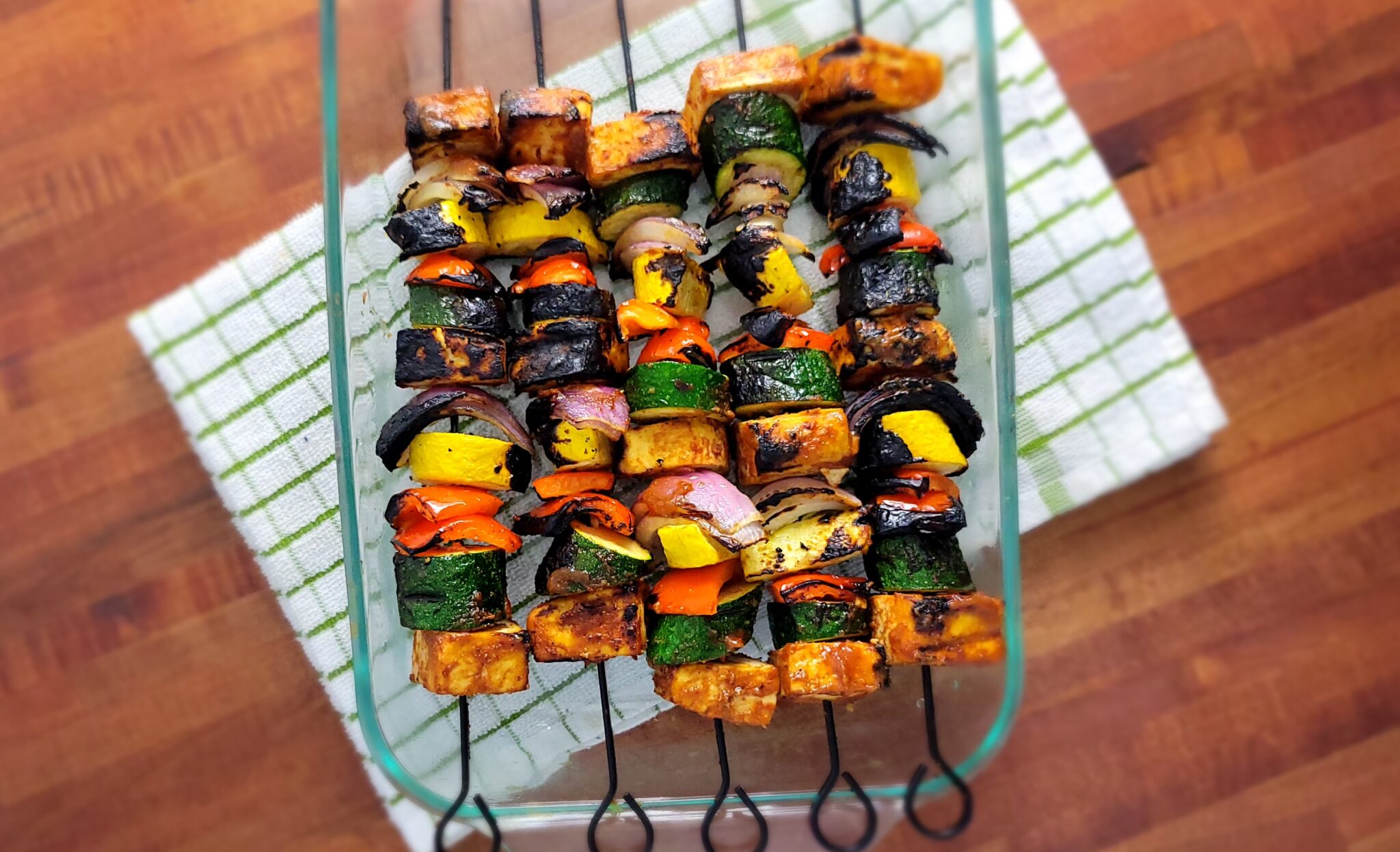
Allspice
What does allspice pair well with?Below you will learn what Allspice tastes like, what it combines well with, and what to use it within the kitchen.
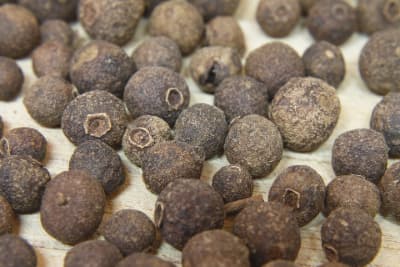 Taste & aroma of allspice:
Taste & aroma of allspice: Allspice has a pleasantly warm, fragrant aroma. The name reflects the pungent taste, which resembles a peppery compound of cloves, cinnamon and nutmeg or mace.
What to use allspice with: Eggplant, most fruit, pumpkins and other squashes, sweet potatoes and other root vegetables.
Allspice combines well with: Chili, cloves, coriander, garlic, ginger, mace, mustard, pepper, rosemary and thyme.

Anise
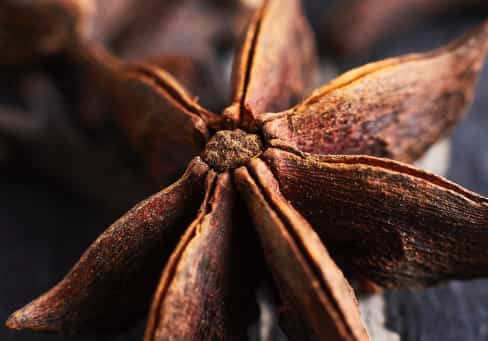 What does star anise pair well with?
What does star anise pair well with?: Chili, cloves, coriander, garlic, ginger, mace, mustard, pepper, rosemary and thyme.
What to use star anise with: Apples, chestnuts, figs, fish and seafood, nuts, pumpkin and root vegetables.
What does stat anise combine with: Allspice, cardamom, cinnamon, cloves, cumin, fennel, garlic, nutmeg, pepper and star anise.
Where do I buy whole organic star anise? You can find whole organic star anise on
Amazon or in your nearest specialty store.

Basil
 Taste & Aroma of basil:
Taste & Aroma of basil: Sweet basil has a complex sweet, spicy aroma with notes of clove and anise. The flavor is warming, peppery and clove-like with underlying mint and anise tones.
What to use basil with: Corn, cream cheese, eggplant, eggs, lemon, mozzarella, cheese, olives, pasta, peas, pizza, potatoes, rice, tomatoes, white beans and zucchini.
What does basil combines well with? Capers, chives, cilantro, garlic, marjoram, oregano, mint, parsley, rosemary and
thyme.

Bay Leaves
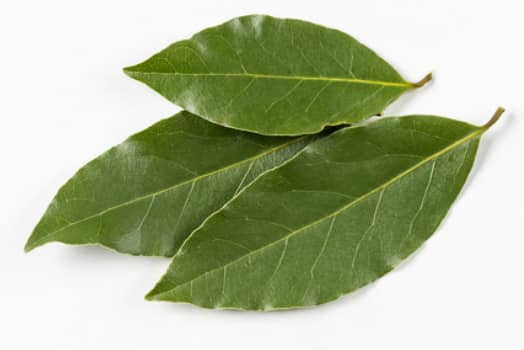 Taste & aroma of bay leaves:
Taste & aroma of bay leaves: Bay has a sweet, balsamic aroma with notes of nutmeg and camphor and a cooling astringency. Fresh leaves are slightly bitter, but the bitterness fades if you keep them for a day or two. Fully dried leaves have a potent flavor and are best when dried only recently.
What to use bay leaves with: Beef, chestnuts, chicken, citrus fruits, fish, game, lamb, lentils, rice, tomatoes, white beans.
What do bay leaves combines well with? Allspice, garlic, juniper, marjoram, oregano, parsley, sage, savory and thyme.

Caraway Seed
What does caraway taste like? Caraway has a pungent aroma that, like the flavor, is warm and bittersweet, sharply spicy, with a note of dried orange peel and a slight but lingering hint of anise.
What does caraway go well with? Good with apples, breads, cabbage, duck, goose, noodles, onions, pork, potatoes and other root vegetables, sauerkraut and tomatoes.

Cayenne
What does cayenne pepper taste like? The most common ground chili, cayenne is made from small, ripe chili peppers grown worldwide. The flavor is tart, slightly smoky and intensely pungent.
What to use cayenne pepper with: Chili powder, curry powders and pastes, harissa, jerk seasoning, Kim chi, moles, and sambals.
What does cayenne pepper go well with? Most spices, bay, coriander, coconut milk, lemon and lime juice.

Cardamom
What does cardamom taste like? The aroma of cardamom is strong but mellow, fruity, and penetrating. The taste is lemony and flowery, with a note of camphor or eucalyptus due to cineol in the essential oil. It is pungent and smoky, with a warm, bittersweet note, yet is also clean and fresh.
What can I use cardamom with? Apples, oranges, pears, legumes, sweet potatoes, and other root vegetables.
What does cardamom go well with? Caraway, chili, cinnamon, cloves, coffee, coriander, cumin, ginger, paprika, pepper, saffron and yogurt.

Celery Seed
What does celery seed taste like? Celery seed has an aroma and taste that is much more pronounced than that of the parent plant. It is penetrating and spicy, with hints of nutmeg, citrus and parsley and it leaves a somewhat bitter, burning aftertaste.
What to use celery seed with: Cabbage, chicken, cucumber, fish, potatoes, rice, soy sauce, tomatoes and tofu.
What does celery seed go well with? Cilantro, cloves, cumin, ginger, mustard, parsley, pepper and turmeric.

Chervil
What does chervil taste like? Sweetly aromatic. The taste is subtle and soothing, with light anise notes and hints of parsley, caraway and pepper.
What to use chervil with: Asparagus, beets, carrots, cream cheese, eggs, fava beans, fennel, fish and seafood, green beans, lettuce, mushrooms, peas, potatoes, poultry, tomatoes and veal.
What does chervil go good with? Basil, chives, cresses, dill, hyssop, lemon thyme, mint, mustard, parsley, salad burnet and tarragon.

Chives
What do chives taste like? Light, onion aroma and a spicy, onion flavor.
What to use chives with: Avocados, cream cheese, egg dishes, fish and seafood, potatoes, smoked salmon, root vegetables and zucchini.
What do chives go well with? Basil, chervil, cilantro, fennel, paprika, parsley, sweet cicely and tarragon.

Cilantro
What does cilantro taste like? Leaves, roots, and unripe seeds all have the same aroma. Some people are addicted to its refreshing, lemony ginger aroma with notes of sage; others hate it and find it soapy and disagreeable. The flavor is delicate yet complex, with a suggestion of pepper, mint, and lemon.
What to use cilantro with: Avocados, coconut milk, corn, cucumber, fish and seafood, legumes, lemons and limes, rice and root vegetables.

Cinnamon
What does cinnamon taste like? Warm agreeably sweet, woody aroma that is delicate yet intense. The taste is fragrant and warm with hints of clove and citrus. The presence of eugenol in the essential oil distinguishes cinnamon from cassia, giving it the note of clove.
What to use cinnamon with: Almonds, apples, apricots, bananas, chocolate, coffee, eggplant, lamb, pears, poultry and rice.
What does cinnamon go well with? Cardamom, cloves, coriander, cumin, ginger, mace, nutmeg, tamarind and turmeric.

Cloves
What do cloves taste like? Assertive and warm, with notes of pepper and camphor. The taste is fruity but also sharp, hot, and bitter; it leaves a numbing sensation in the mouth. As in allspice, eugenol in the essential oil is mainly responsible for the characteristic taste.
What to use cloves with: Apples, beets, red cabbage, carrots, chocolate, ham, onions, oranges, pork, pumpkin and
other squashes and sweet potatoes.
What do cloves go well with? Allspice, bay, cardamom, cinnamon, chili, coriander, curry leaves, fennel, ginger, mace, nutmeg and tamarind.

Coriander
What does coriander taste like? Ripe seeds have a sweet, woody, spicy fragrance with peppery and floral notes; the taste is sweet, mellow and warm with a clear hint of orange peel.
What to use coriander with: Apples, chicken, citrus fruit, fish, ham, mushrooms, onions, plums, pork and potatoes.
What does coriander go well with? Allspice, chili, cinnamon, cloves, cumin, fennel, garlic, ginger, mace and nutmeg.

Cumin
What does cumin taste like? The smell of cumin is strong and heavy, spicy-sweet with acrid but warm depth. The flavor is rich, slightly bitter, sharp, earthy, and warm, with a persistent pungency. Use sparingly.
What to use cumin with: Beans, bread, cabbage, hard or pungent cheeses,
chicken, eggplant, lamb, lentils, onions, potatoes, rice, sauerkraut and squash.
What does cumin go well with? Allspice, anise seed, bay, cardamom, chili, cinnamon, cloves, coriander, curry leaves, fennel seed, fenugreek, garlic, ginger, mace and nutmeg, mustard seed, oregano, paprika, pepper, thyme and turmeric.

Dill
What does dill taste like? Dill leaves have a clean, fragrant aroma of anise and lemon. The taste is of anise and parsley, mild but sustained. The seeds smell like a sweet caraway due to carvone in the essential oil; the taste is of anise with a touch of sharpness and lingering warmth.
What to use dill with: Beets, carrots, celery root, cucumber, eggs, fava beans, fish and seafood, potatoes, rice, spinach, and zucchini.
What does dill go well with? Basil, capers, garlic, horseradish, mustard, paprika and parsley.
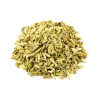
Fennel
What does fennel taste like? The whole plant has a warm, anise-licorice aroma. The taste is similar: pleasantly fresh, slightly sweet, with a hint of camphor. Fennel seed is less pungent than dill and more astringent than anise.
What to use fennel with: Beans, beets, cabbage, cucumber, duck, fish and seafood, leeks, lentils, pork, potatoes, rice and tomatoes.
What does fennel go well with? Chervil, cinnamon, cumin, fenugreek, lemon balm, mint, parsley, Sichuan pepper and thyme.

Fenugreek
What does fenugreek taste like? The aroma of the raw seeds can be identified as the overriding smell of some curry powders. Their taste is celery or lovage-like and bitter; the texture is floury.
What to use fenugreek with: Fish curries, green and root vegetables, lamb, legumes, potatoes, rice and tomatoes.
What does fenugreek go well with? Cardamom, cinnamon, cloves, coriander, cumin, fennel seed, garlic, dried limes,
pepper and turmeric.
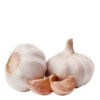
Garlic
What does garlic taste like? Raw dried garlic is pungent and hot; green garlic is milder. The disulphate allicin is formed when raw garlic is cut, and this accounts for the smell that raw garlic leaves on the breath. Cooking garlic degrades the allicin, but forms other disulphates that have fewer odors.
What to use garlic with: Almost anything savory.
What does garlic go well with? Most herbs and spices.

Ginger
What does ginger taste like? Whole dried ginger is less aromatic than fresh, but once bruised or powdered it is warm and peppery with light, lemony notes. The taste is fiery, pungent, and penetrating.
What to use ginger with: Soups, rice, ramen, noodle dishes. Curry and masala blends, five spice powder and pickling spices.
What does ginger go well with? Cardamom, cinnamon, cloves, dried fruits, honey, nutmeg, nuts, preserved lemons, paprika, pepper, rose water and saffron.

Mace
What does mace taste like? Mace has nutmeg’s rich, fresh, and warm aroma, but the smells are stronger and show a lively, floral character with notes of pepper and clove. The taste of mace is warm, aromatic, delicate, and subtle with some lemony sweetness, yet it finishes with a potent bitterness.
What to use mace with: Cabbage, carrots, cheese and cheese dishes, chicken, egg dishes, fi h and seafood
chowders, lamb, milk dishes, onion, pates and terrines, potato, pumpkin pie, spinach, sweet potato and veal.
What does mace combine well with? Cardamom, cinnamon, cloves, coriander, cumin, ginger, nutmeg, paprika, pepper and thyme.

Marjoram
What does marjoram taste like? The basic taste is warm, slightly sharp and bitter with a note of camphor. To this marjoram adds a sweet, subtle spiciness, even in temperate climates.
What to use marjoram with: Anchovies, artichokes, beans, cabbage, carrots,
cauliflower, cheese dishes, chicken, corn, duck, eggplant, eggs, fish and shellfish, lamb, mushrooms, onions, pork, potatoes, poultry, spinach, squash, sweet peppers, tomatoes, veal and venison.
What does marjoram go well with? Basil, bay, chili, cumin, garlic, paprika, parsley, rosemary, sage, sumac and thyme.

Mustard seed
What does mustard seed taste like? Whole mustard seed has virtually no aroma. When ground it smells pungent, and cooking releases an acrid, earthy aroma. When chewed, black seeds have a forceful flavor; brown ones are slightly bitter, then hot and aromatic; the larger white seeds have an initial sickly sweetness.
What to use mustard seed with: Roast and grilled beef, cabbage, strong cheeses, chicken, curries, dals, fish and seafood, cold meats, rabbit and sausages.
What does mustard seed go well with? Bay, chili, coriander, cumin, dill, fennel, fenugreek, garlic, honey, parsley, pepper, tarragon and turmeric.

Nutmeg
What does nutmeg taste like? Nutmeg and mace have a similar rich, fresh, warm aroma. Nutmeg smells sweet but is more camphorous and pine-like than mace. The taste of both is warm and highly aromatic, but nutmeg has hints of clove and a deeper, bittersweet, woody flavor.
What to use nutmeg with: Cabbage, carrots, cheese and cheese dishes, chicken, eggs, fish and seafood chowders, lamb, milk dishes, onion, potato, pumpkin pie, spinach, sweet potato and veal.
What does nutmeg go well with? Cardamom, cinnamon, cloves, coriander, cumin, ginger, mace, pepper and thyme.

Oregano
What does oregano taste like? The basic taste is warm, slightly sharp, and bitter with a note of camphor. Oregano is robust and peppery, with a bite and often a lemony note. These qualities diminish in colder climates.
What to use oregano with: Anchovies, artichokes, beans, cabbage, carrots, cauliflower, cheese dishes, chicken, corn, duck, eggplant, eggs, fish and shellfish, lamb, mushrooms, onions, pork, potatoes, poultry, spinach, squash, sweet peppers, tomatoes, veal and venison.
What does oregano go well with? Basil, bay, chili, cumin, garlic, paprika, parsley, rosemary, sage, sumac and thyme.

Paprika
What does paprika taste like? The aroma of paprika tends to be restrained and delicate; caramel notes, fruitiness or smokiness characterize some paprikas, while others have a nose prickling, light heat. Flavors vary from sweetly smoky to rounded and full-bodied, or gently pungent with bitter notes.
What to use paprika with: Beef and veal, white cheeses, chicken, duck, most legumes and vegetables, pork and rice.
What does paprika go well with? Allspice, caraway, cardamom, garlic, ginger, oregano, parsley, pepper, rosemary, saffron, thyme, turmeric, sour cream and yogurt.

Parsley
What does parsley taste like? Parsley has a lightly spicy aroma with hints of anise and lemon; its taste is tangy and herbaceous, and has a light, peppery note. Flat-leaf parsley has a more persistent and finer flavor than curly parsley and a finer texture. Both bring out the flavors of other seasonings.
What to use parsley with: Eggs, fish, lemon, lentils, rice, tomatoes and most vegetables.
What does parsley go well with? Basil, bay, capers, chervil, chili, chives, garlic, lemon balm, marjoram, mint, oregano, pepper, rosemary, sorrel, sumac and tarragon.

Peppercorn
What do peppercorns taste like? Black pepper has a fine fruity, pungent fragrance with warm, woody and lemony notes. The taste is hot and biting with a clean, penetrating aftertaste. White pepper is less aromatic and can smell musty, but it has a sharp pungency with a sweetish after note. Red or pink peppercorns are fully ripe fruits, usually available preserved in brine or vinegar. They have a soft outer shell with a delicate, almost sweet, fruity taste. The inner core provides a moderate, lingering heat. Green
pepper has light aroma, and an agreeable, fresh pungency; it is not overpoweringly hot. Green peppercorns are preserved
by freeze-drying or dehydration, or packed in brine or vinegar. Keep fresh green and red pepper berries in the refrigerator.
What to use peppercorns with: Most foods.
What do peppercorns go well with? Basil, cardamom, cinnamon, cloves, coconut milk, coriander, cumin, garlic, ginger, lemon, lime, nutmeg, parsley, rosemary, thyme, and turmeric.

Rosemary
What does rosemary taste like? Rosemary is strongly aromatic, warm and peppery, resinous and slightly bitter, with notes of pine and camphor. Nutmeg and camphor are present in the taste; the aftertaste is woody, balsamic and astringent. The flavor dissipates after leaves are cut. Flowers have a milder flavor than leaves.
What to use rosemary with: Apricots, cabbage, cream cheese, eggplant, eggs, fish, lamb, lentils, mushrooms, onions, oranges, parsnips, pork, potatoes, poultry, rabbit, tomatoes, veal and winter squashes.
What does rosemary go well with? Bay, chives, garlic, lavender, lovage, mint, oregano, parsley, sage, savory and thyme.

Sage
What does sage taste like? Sage can be mild, musky, and balsamic, or strongly camphorous with astringent notes and a warm spiciness. Generally, variegated species are milder than common sage. Dried sage is more potent than fresh and can be acrid and musty.
What to use sage with: Apples, dried beans, cheese, onions and tomatoes.
What does sage go well with? Bay, caraway, cutting celery, dried ginger, lovage, marjoram, paprika, parsley, savory and thyme.

Savory
What does savory taste like? Savories have a peppery bite. Summer savory has a subtle, herbaceous scent and flavor. It is agreeably piquant, slightly resinous, and reminiscent of thyme, mint, and marjoram. Winter savory has a more assertive, penetrating aroma and flavor, with notes of sage and pine.
What to use savory with: Beans, beets, cabbage, cheese, eggs, fish, legumes, potatoes, rabbit, sweet peppers and tomatoes.
What to combine savory with: Basil, bay, cumin, garlic, lavender, marjoram, mint, oregano, parsley, rosemary and thyme.

Tarragon
What does tarragon taste like? The leaves are sweetly aromatic, with hints of pine, anise, or licorice; the flavor is strong yet subtle, with spicy anise and basil notes and a sweet aftertaste. Long cooking diminishes the aroma but the flavor is not lost.
What to use tarragon with: Artichokes, asparagus, eggs, fish and seafood, potatoes, poultry, tomatoes and zucchini.
What does tarragon go well with? Basil, bay, capers, chervil, chives, dill, parsley and salad herbs.

Thyme
What does thyme taste like? The whole plant has a warm, earthy, and peppery fragrance when lightly bushed. The taste is spicy, with notes of cloves and mint, a hint of camphor, and a mouth-cleansing aftertaste.
What to use thyme with: Cabbage, carrots, corn, eggplant, lamb, leeks, legumes, onions, potatoes, rabbit, tomatoes, and wild mushrooms.
What does thyme go well with? Allspice, basil, bay, chili, clove, garlic, lavender, marjoram, nutmeg, oregano, paprika, parsley, rosemary and savory.

Turmeric
What does turmeric taste like? Fresh turmeric is crunchy, has gingery, citrus aromas and an agreeably earthy flavor with citrus overtones. Dried turmeric has a complex, rich, woody aroma with floral, citrus and ginger notes. The taste is slightly bitter and sour, moderately pungent, warm and musky.
What to use turmeric with: Beans, eggplant, eggs, fish, lentils, meat, poultry, rice, root vegetables and spinach.
What does turmeric go well with? Chili, cilantro, cloves, coconut milk, coriander, cumin, curry leaf, fennel, galangal, garlic, ginger, kaffir, lime leaves, lemon grass, mustard seeds, paprika and pepper.
 Allspice
Allspice Taste & aroma of allspice: Allspice has a pleasantly warm, fragrant aroma. The name reflects the pungent taste, which resembles a peppery compound of cloves, cinnamon and nutmeg or mace.
What to use allspice with: Eggplant, most fruit, pumpkins and other squashes, sweet potatoes and other root vegetables.
Allspice combines well with: Chili, cloves, coriander, garlic, ginger, mace, mustard, pepper, rosemary and thyme.
Taste & aroma of allspice: Allspice has a pleasantly warm, fragrant aroma. The name reflects the pungent taste, which resembles a peppery compound of cloves, cinnamon and nutmeg or mace.
What to use allspice with: Eggplant, most fruit, pumpkins and other squashes, sweet potatoes and other root vegetables.
Allspice combines well with: Chili, cloves, coriander, garlic, ginger, mace, mustard, pepper, rosemary and thyme.
 Anise
Anise What does star anise pair well with?: Chili, cloves, coriander, garlic, ginger, mace, mustard, pepper, rosemary and thyme.
What to use star anise with: Apples, chestnuts, figs, fish and seafood, nuts, pumpkin and root vegetables.
What does stat anise combine with: Allspice, cardamom, cinnamon, cloves, cumin, fennel, garlic, nutmeg, pepper and star anise.
Where do I buy whole organic star anise? You can find whole organic star anise on Amazon or in your nearest specialty store.
What does star anise pair well with?: Chili, cloves, coriander, garlic, ginger, mace, mustard, pepper, rosemary and thyme.
What to use star anise with: Apples, chestnuts, figs, fish and seafood, nuts, pumpkin and root vegetables.
What does stat anise combine with: Allspice, cardamom, cinnamon, cloves, cumin, fennel, garlic, nutmeg, pepper and star anise.
Where do I buy whole organic star anise? You can find whole organic star anise on Amazon or in your nearest specialty store.
 Basil
Basil Taste & Aroma of basil: Sweet basil has a complex sweet, spicy aroma with notes of clove and anise. The flavor is warming, peppery and clove-like with underlying mint and anise tones.
What to use basil with: Corn, cream cheese, eggplant, eggs, lemon, mozzarella, cheese, olives, pasta, peas, pizza, potatoes, rice, tomatoes, white beans and zucchini.
What does basil combines well with? Capers, chives, cilantro, garlic, marjoram, oregano, mint, parsley, rosemary and
thyme.
Taste & Aroma of basil: Sweet basil has a complex sweet, spicy aroma with notes of clove and anise. The flavor is warming, peppery and clove-like with underlying mint and anise tones.
What to use basil with: Corn, cream cheese, eggplant, eggs, lemon, mozzarella, cheese, olives, pasta, peas, pizza, potatoes, rice, tomatoes, white beans and zucchini.
What does basil combines well with? Capers, chives, cilantro, garlic, marjoram, oregano, mint, parsley, rosemary and
thyme.
 Bay Leaves
Bay Leaves Taste & aroma of bay leaves: Bay has a sweet, balsamic aroma with notes of nutmeg and camphor and a cooling astringency. Fresh leaves are slightly bitter, but the bitterness fades if you keep them for a day or two. Fully dried leaves have a potent flavor and are best when dried only recently.
What to use bay leaves with: Beef, chestnuts, chicken, citrus fruits, fish, game, lamb, lentils, rice, tomatoes, white beans.
What do bay leaves combines well with? Allspice, garlic, juniper, marjoram, oregano, parsley, sage, savory and thyme.
Taste & aroma of bay leaves: Bay has a sweet, balsamic aroma with notes of nutmeg and camphor and a cooling astringency. Fresh leaves are slightly bitter, but the bitterness fades if you keep them for a day or two. Fully dried leaves have a potent flavor and are best when dried only recently.
What to use bay leaves with: Beef, chestnuts, chicken, citrus fruits, fish, game, lamb, lentils, rice, tomatoes, white beans.
What do bay leaves combines well with? Allspice, garlic, juniper, marjoram, oregano, parsley, sage, savory and thyme.
 Caraway Seed
Caraway Seed Cayenne
Cayenne Cardamom
Cardamom Celery Seed
Celery Seed Chervil
Chervil Chives
Chives Cilantro
Cilantro Cinnamon
Cinnamon Cloves
Cloves Coriander
Coriander Cumin
Cumin Dill
Dill Fennel
Fennel Fenugreek
Fenugreek Garlic
Garlic Ginger
Ginger Mace
Mace Marjoram
Marjoram Mustard seed
Mustard seed Nutmeg
Nutmeg Oregano
Oregano Paprika
Paprika Parsley
Parsley Peppercorn
Peppercorn Rosemary
Rosemary Sage
Sage Savory
Savory Tarragon
Tarragon Thyme
Thyme Turmeric
Turmeric
